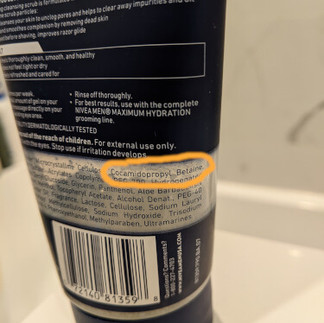Cocamidopropyl Betaine in Toothpaste: Benefits & Safety
- David Chen, DDS
- Dec 22, 2023
- 5 min read
Cocamidopropyl Betaine as a toothpaste ingredient is a surfactant/foaming agent that cleans the teeth by reducing surface tension and dispersing the paste. It is considered to be a safer alternative to sodium lauryl sulfate but it does come with some disadvantages.
Below is a summary of things to know about it when it's used in a dentifrice.
Cocamidopropyl Betaine in toothpaste overview:
Description: Coconut oil derived amphoteric surfactant.
Benefits: Foaming; Wetting; Removes food/plaque/stains.
Side effects: Dermal irritation; Allergen.
Synergists: Fluoride.
Safety: Safe for cosmetic use; No oral toxicity; No carcinogenicity.
What is it?
Cocamidopropyl betaine (CAPB) is an amphoteric synthetic surfactant that is commonly used in cosmetics and personal hygiene products. It can also be derived from organic sources such as coconut oil.

What it looks like: Light yellow to clear liquid with a gentle odor.
Shampoos
Contact lens solutions
Toothpaste detergents
Makeup removers
Bath gels
Skin care products
Cleansers
Liquid soaps
Antiseptics
Gynecologic and anal hygiene products
Emphasis on, it can be found in a LOT of hygiene products, including toothpaste. The more "natural soaps" use it in lieu of SLS such as the Puracy detergent that my household has been using for the past 5 years.

Not so much me... but my significant other is very into having more natural products that aren't as harsh on your skin since she does have more sensitive skin.
If you look at the ingredients label for this plant powered detergent, it uses cocamidopropyl betaine! They also put in parenthesis that it is a coconut-based cleanser to make sure that you know it came from natural sources.

To be clear, yes it is called a surfactant but you can pretty much think of it as a soap. It helps you clean your clothes and in the case for oral hygiene, it helps to clean your teeth.
Effects in toothpaste
The predominant effect of cocamidopropyl betaine as a toothpaste ingredient is to help clean the dentition. This includes the removal of plaque, food, debris, and even stains from the enamel surfaces.

Although most people probably know it as a foaming agent which is technically correct since it is a soap.
CAPB benefits in dentifrices:
Cleans teeth by loosening up plaque, food, and debris via emulsification.
Teeth whitening by removing stains.
Wetting agent to help disperse toothpaste along tooth surfaces.
Foam boosting.
Antibacterial properties.
Cleans teeth
How CAPD or rather surfactants clean teeth is by loosening up the plaque and debris along the surfaces via emulsification. That is an inherent property of soaps and detergents.

Surfactants have a hydrophilic head and hydrophobic tail.
Hydrophobic-loving tail surrounds the oils and fats, forming a circular structure called a micelle.
This leaves the hydrophilic head on the outside of the micelle with the hydrophobic tail on the inside of the michelle.
Since the outside of the micelle is attracted to water, it gets washed away.

In summary, the dual hydrophilic/hydrophobic nature is how it loosens up debris and gets it to wash off. All surfactants work in the same way and this includes sodium lauryl sulfate.
Whitens teeth
The cleansing nature of CAPD can also help whiten the teeth because it will remove extrinsic stains on teeth. All whitening toothpastes will contain some type of detergent to help with the stain removal process.
Without a surfactant, it would have a difficult time keeping your teeth clean and white. In other words, it wouldn't be a very effective whitening toothpaste. Although efficacy-wise, SLS is a much more effective tooth whitener than CAPD. I'm just being honest here.
Wets tooth surfaces
Another function of cocamidopropyl betaine is to help wet the teeth surfaces by lowering the surface tension. This helps to disperse the toothpaste more readily and easily throughout the mouth.
What that does is help all of the beneficial toothpaste ingredients get into the nooks and crannies to work their magic.
Foaming agent
CAPD is a foaming agent in that it creates a lot of foam. This not only helps the cleaning process but also reduces the amount of soap required to do the job.
You may have noticed that the most potent surfactant SLS will create a lot of foam while its less harsh counterpart, CAPD will foam less. Toothpastes without SLS often have very little foaming. Yes, the CAPD will still create foam but just a lot less of it.
Antibacterial
All surfactants, including the less harsh cocamidopropyl betaine do possess antibacterial properties. Therefore, having it in the dentifrice formulation can help reduce the overall bacteria population in the mouth.
Synergists
Cocamidopropyl betaine can help with remineralizing damaged tooth structure as well has boost fluoride concentrations at least when compared to SLS.
Remineralization. Studies have shown that toothpastes with CAPD exhibited significantly greater remineralization of carious lesions when compared to SLS.
Higher fluoride concentration. Studies demonstrated that CAPD toothpastes had higher residual fluoride in the mouth when compared to SLS toothpastes with tetrasodium pyrophosphate.
What all of this means for you is that, CAPD is the better surfactant to use in remineralization toothpastes. The effects are synergistic rather than antagonistic such as with other surfactants.
Side effects
While CAPD is less harsh than other surfactants, it isn't free of all side effects.
Potential adverse effects:
Allergen causing contact dermatitis. A case report of a 10 year old girl who had a 2 year severe history of cheilitis on the lips. It resolved once she switched to a non-CAPD toothpaste.
Canker sores. There has been some potential evidence of harsh surfactants making canker sores worse although the research is mixed and inconclusive.
Bitter tasting. This surfactant does have a more bitter taste than others. For this reason, it is recommended to mix it with a different surfactant to minimize the poor taste. Or you can add more sweeteners.
Overall, cocamidopropyl betaine is a potential allergen where contact sensitization has been estimated between 3-7.2%. That means not everyone will have a reaction to it but it is possible.
If you wanted additional proof, you can also read this case report of an 81 year old man with allergic contact dermatitis from CAPD.
Is cocamidopropyl betaine safe in toothpaste?
SLS is the most common surfactant that is used in toothpaste and cocamidopropyl betaine was introduced as a better/safer alternative to it. It is supposed to have less side effects while still being able to clean your teeth.
Less mucosal irritation.
Less foaming.
More biocompatible.
More natural since it is derived from coconuts.
While CAPD is safe to use in toothpaste, it is still considered cytotoxic meaning it can be harmful to living cells especially in high concentrations.
Studies about its cytotoxicity:
Surfactants in general ARE cytotoxic.
SLS along with CAPD strongly inhibited cell viability.
Although the half-lethal concentration of CAPD is higher than SLS.
Overall, it is less toxic than SLS and that is why I consider it as a safer alternative. Manufacturers need to be mindful of not putting too much of it into toothpaste because it can be detrimental.
Verdict
All toothpastes need to have some type of surfactant so that it can effectively/efficiently clean your teeth. Cocamidopropyl seems like a great choice at least when compared to SLS which is harsher and has more side effects.
Based on my own personal observations, I've noticed that a lot of the more natural soaps/detergents often replace SLS with CAPD. If all of the health conscious people are using it, it means that they approve of it as a safe ingredient. After all, it is derived from a food source, coconut.
With that being said, if I wanted to improve upon surfactants for toothpastes, I would look into cocamidopropyl hydroxysultaine, which is related to CAPD. I've been hearing that it may be an even safer alternative but I've yet to see a toothpaste with it.
This article is written by our dentists in Long Island City.




